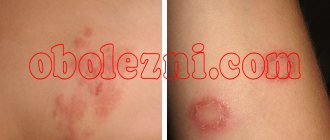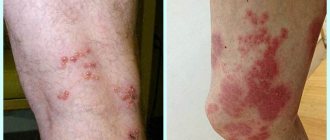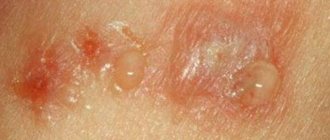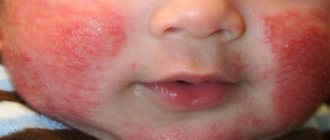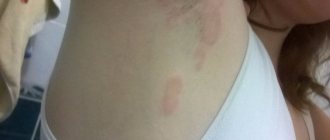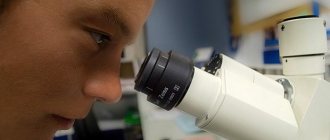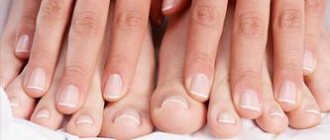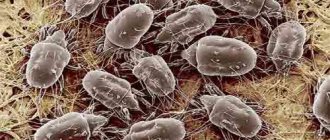Onychomycosis is a fungal infection that is caused by pathogens of various species and affects the nail plates of the hands and feet. Nail fungus is rare in children, but recently pediatricians and dermatologists have seen an increase in cases of the disease in young patients. The fungus brings discomfort, causes psychological stress, and embarrassment in front of peers.
How do children get infected?
Mycotic infections at an early age have a more complex course than in adults. The child often complains of itching, burning and pain in the area of the lesion, which, in turn, swells and becomes red. These symptoms require immediate contact with a medical facility, since there is a high probability of losing a nail. So how does infection occur?
The main cause of nail fungus is infection with onychomycosis pathogens. Children are at risk for this disease, since they are more often in groups with peers, for example, in kindergarten, sports section, school. Walking barefoot on a bare floor, close contact with other children, and the presence of a sick person at home - all this leads to the intensive spread of mycosis.
According to statistics from dermatovenerological clinics, 80% of children become infected with nail fungus in the family. The remaining 20% of cases are caused by plate injuries and occurred while the child was attending preschool. The most common types of fungus in pediatrics are Trichophyton rubrum and Trichophyton mentagrophytes.
But catching an infection is not everything; the pathological process develops against the background of the following favorable factors:
- weakened immune system;
- poor nutrition;
- hypo- and vitamin deficiency;
- wearing uncomfortable shoes;
- flat feet.
It is difficult to protect a child from fungal infection, but every parent can detect the disease at an early stage and consult a doctor. In this case, the treatment will be simple and painless.
When does a child become infected?
Statistics show that more than 80% of children become infected from their parents. The remaining 20% comes from swimming pools, changing rooms in schools or kindergartens, where a large number of children walk barefoot. The fungus can also appear if personal hygiene rules are not followed. To avoid this, you need to trim your nails regularly and keep them clean. Tight and non-breathable children's shoes are another factor that contributes to the occurrence of fungal infections. You should not save on boots, since in winter the child is forced to wear them for a long time. If the material from which they are made is not natural, then due to overheating of the foot, microorganisms will begin to multiply intensively, which will be an ideal environment for their growth.
More on Med-Gribok.Ru:
Treatment of nail fungus with hydrogen peroxide
Toenail fungus
At the initial stage, it is not easy to notice onychomycosis on the legs. If the infection occurred relatively recently, there will be no significant external changes in the structure of the nail plate. But at this time, the infectious agents are already in full swing in its structure, trying to penetrate as deeply as possible in search of better conditions for nutrition and reproduction.
Approximately 6 weeks after infection, with the active development of the disease, that is, the presence of favorable conditions, the nails begin to change as described in the table.
| Changes | Description |
| COLOR | The plates lose their transparency and natural pink color. When infected with a fungus, they become dull, yellow, with spots of white or gray. The stronger the pathological process, the darker the nail. |
| RELIEF | The surface of the plate becomes uneven, bumpy, and rougher. |
| STRUCTURE | Gradually loses its natural strength. Fabrics begin to crumble, delaminate, and break. |
| CUTICLE | The skin around the nail becomes red and swollen, which indicates the presence of inflammatory processes in it. |
If there is no treatment, over time the fungus will completely deform and destroy the plate. As a result, it peels off, which, however, does not bring relief. The infection spreads to the skin and nearby nails, capturing new territories.
Signs, diagnosis and treatment of fungus in children
Symptoms of a fungal infection do not appear immediately, since the process of its development is quite long. Manifestations of the disease at the initial stage are minimal, and it is very difficult to notice them; as it grows, the following signs develop:
- increased dryness of the skin;
- the appearance of cracks in the skin between the fingers;
- formation of hangnails and cracks in the periungual area on the hands and feet;
- calluses often appear on the soles of the feet, the skin becomes tougher and thicker;
- the nail plates thicken significantly, and their depletion is also possible;
- deformation of the nails occurs, they acquire uneven edges, peel and crumble;
- White spots appear on the plates, then their color changes, they can acquire a yellowish, grayish and light green tint;
- swelling and redness of the skin near the fingers;
- itching feeling.
During infection, weakness, constant fatigue, and irritability appear. Babies can also often be capricious and refuse to play or eat. Treatment of the fungus will directly depend on the stage at which the disease is detected. If the infection is detected at the beginning of its development, treatment will be carried out much faster and easier than when the disease is advanced.
If fungus is detected on a child’s nail, therapy is carried out after diagnostic measures. To do this, first of all, you should visit a dermatologist, who will help prescribe the necessary measures to make an accurate diagnosis. The examination includes a general examination of the affected areas, then a scraping is taken from them and sent to the laboratory to identify the pathogen. In addition, to find out the full picture of the disease and its cause, children may be recommended a general blood and urine test; it is also possible to prescribe an additional examination, which may include an ultrasound of internal organs, a sugar test, etc.
Nail fungus on hands
Onychomycosis on the hands is much less common. Unlike pathology localized on the legs, the nail plates do not undergo profound painful changes. Usually the shape of the nail does not lose its original appearance, but its surface acquires some roughness.
In the absence of treatment and the addition of a secondary infection, rotting processes begin underneath it, and sometimes hyperkeratosis is formed. The color of the plates practically does not change, but spots of yellow and gray shades appear on them in the form of characteristic stripes.
Symptoms
There are main symptoms of any type of mycoses - redness of the skin, itching and burning. Fungal infections mainly affect the scalp, fingernails and toenails, as well as locally the skin.
Other symptoms of fungal infection include the following:
- lumpiness of the skin;
- skin cracks;
- change in skin color to gray;
- peeling and the appearance of scales;
- hair loss in a certain area;
- constant scratching of the affected area;
- blisters and blisters on the skin;
- dense crusts;
- damage to the mucous membranes with a white coating (tonsils, vagina);
- bleeding areas;
- change in nail color, peeling nails;
- erosions and ulcers on the skin.
Any of these symptoms is a reason to consult a doctor for advice.
Forms and stages of the disease
There are several forms of onychomycosis. Let's list them:
- Distal subungual. Occurs most often. At an early stage, it is characterized by the appearance of a yellow spot on the affected plate, which tends to grow until it covers its entire area. If left untreated, the nail easily peels off from the cuticle.
- White superficial. The fungus affects only the horny surface layer of the plate. At the same time, it does not become thicker and rougher; the main sign of the disease is a whitish unnatural coating. Gradually, the nail begins to lose its elasticity, acquires a soft and pliable structure, and becomes severely exfoliated. This type of pathology is easily treated with medications, especially when it comes to the early stage of onychomycosis.
- Proximal subungual. The infectious process is initially concentrated near the cuticle, and then spreads to the entire area of the plate, painting it matte white. The disease is quite rare, most often in people suffering from HIV and AIDS.
- Total dystrophic. The most serious form of onychomycosis. It is characterized by local destruction of the nail plate and low effectiveness of conservative treatment.
Fungal infection, like many diseases, occurs in stages. It is characterized by the following stages of the pathological process:
- FIRST STAGE. The nail loses its transparency and healthy appearance. Changes are also noted in its structural structure - the plate becomes thinner and begins to exfoliate, but its integrity and shape remain original.
- SECOND PHASE. Spots of various sizes and shades appear on the nails - from yellow to brown. The relief of the plate loses its usual smoothness and becomes thicker.
- THIRD STAGE. At the last final stage of the disease, nail deformation reaches its peak. The structure is completely destroyed and begins to separate from the cuticle, the color becomes close to black, and an unpleasant smell of rotting emanates from the hands or feet. Secondary bacterial infections are often associated. At this stage, drug treatment is no longer effective; more radical methods have to be resorted to.
Stages of onychomycosis
It is customary to distinguish the following stages of this disease:
- stage 1 – thinning of the nail, clouding, loss of shine and slight peeling;
- stage 2 – spots appear that can be of different colors, both white and brown, the nail becomes less smooth and even, the plate thickens significantly;
- stage 3 - the stage when the nail is completely modified, it darkens, becomes even more deformed and has a specific putrefactive odor; a secondary bacterial infection cannot be ruled out.
Diagnostics
If you notice the first symptoms of mycosis on the hands or feet, in particular, negative external changes in the child’s nail plates, you need to show him to a specialist. During a visual examination, the doctor will confirm or refute the suspicions that have arisen and refer the baby for analysis.
A special laboratory test will help determine the specific causative agent of the infection; for this, a small piece of the nail plate is taken for diagnosis under a microscope. Based on the identified type of onychomycosis, the doctor selects treatment.
Signs of the disease
In the initial stage, mycosis in a child is manifested by dry skin on the legs, peeling and itching. The limbs have an unpleasant odor due to increased sweating of the feet.
As mycosis develops, blisters or weeping sores begin to form throughout the foot, which are dangerous because they are an entry point for various bacteria.
The nail plate changes color, wears out and peels off. Painful cracks may appear on the heels, which begin to bleed under mechanical stress.
Treatment
To combat nail fungus in a child, local medications are most often used. Usually the specialist chooses the following means:
- sprays Mikostop, Mikozan - easy to use, easy to apply and absorb into the surface being treated;
- varnishes Lamisil, Exoderil - when applied once a day, they have a prolonged effect, gradually accumulating in the tissues and providing a continuous therapeutic effect;
- ointments and creams Mikozan, Terbinafine - have a strong anti-inflammatory effect, actively fight the symptoms of the disease, and provide a decent antifungal result.
Experts insist on a combined approach to the treatment of onychomycosis, that is, a simultaneous combination of oral and local medications. Thus, the child is additionally prescribed tablets for oral administration, which enhance the effect of external medications.
Typically, their list includes antimycotics - agents that destroy fungal flora in the body, and drugs that improve the condition of the immune system. This approach guarantees complete relief from the mycotic infection in a faster time.
Table of drugs
Let's consider which medications are used most often in childhood.
| Drug name | Recommendations, treatment regimen |
| DIFLUCAN (FLUCONAZOLE) | The most effective and safe remedy for a child with diagnosed onychomycosis. Available in capsule form. Recommended use is once a week. It has no contraindications and virtually no side effects. Cost 438 rub. for one capsule in Russia and 298 hryvnia in Ukraine. |
| TERBINAFINE | At the initial stage of onychomycosis, it is prescribed to children in the form of an ointment; at an advanced stage, tablets are included in the course of therapy. The drug is approved for young patients; its use may be limited by the development of side effects in the form of allergies, disruption of the gastrointestinal tract and nervous system, etc. The dosage of Terbinafine depends on the weight of the child. The cost of a package of 10 tablets in Russia is 184 rubles, in Ukraine - 71 hryvnia. |
| CLOTRIMAZOLE | It is often used for onychomycosis in pediatrics due to the availability, safety and effectiveness of the drug. The drug is prescribed as an ointment. The product is applied 2 times a day to the child’s nails, the recommended course is 4 weeks. The cost of the medicine in Russia for a 20 ml tube is 128 rubles, in Ukraine - 56 hryvnia. |
| GRISEOFULVIN | A mild remedy that is effective in the initial stages of fungal infection. Available in tablet form. Prescribed to small patients at a rate of 16 mg/kg body weight. The recommended duration of treatment for nail fungus is 8 months. The cost of a package of the drug, consisting of 20 pills, is 274 rubles in Russia and 74 hryvnia in Ukraine. |
| MYCOZORAL (KETOCONAZOLE) | Available in the form of ointments and tablets. In case of advanced onychomycosis, complex use of funds is prescribed. The recommended dosage for children is 100 mg per day and a single treatment of the nail with ointment. The course of therapy should be continued until the symptoms of the disease disappear. The cost of a package of 30 tablets is 530 rubles in Russia, 210 hryvnia in Ukraine. |
| EXODERIL (NAFTIFIN) | Available in the form of medicinal solutions and gels. The drug is used to treat the nail plates 2 times a day. The recommended course for onychomycosis is 6 months. The product extremely rarely causes side effects and has virtually no contraindications. The cost of the medicine in Russia is 584 rubles, in Ukraine - 312 hryvnia. |
The result of successful therapy is the growth of new healthy nail tissue, so it usually lasts for a long time. It is under no circumstances recommended to interrupt the treatment that has been started, since there is a high probability of relapse of the pathology and the development of resistance to the used antimycotics in the causative agents of the infection.
How to prevent infection
To keep your child’s nails healthy, you must adhere to the following rules:
- keep the baby's feet clean and dry, dry thoroughly after bathing;
- nails should be cut short, the use of varnish is undesirable;
- socks need to be changed daily;
- The child should not be allowed to walk barefoot in public places;
- To prevent contact with fungus, you should use antifungal agents for shoes and feet.
The prognosis for onychomycosis in children is favorable.
It can take up to 18 months to cure the disease in a child. Relapses occur frequently, so the approach to therapy and prevention must be serious.
Traditional methods of treatment
Is it possible to get rid of the disease at home? Alternative medicine for nail fungus in children is popular among parents. Of course, it would be a stretch to call them highly effective, but the use of folk recipes one way or another gives results.
To recover from onychomycosis, it is recommended to use the following recipes.
1. Prepare herbal baths for hands and feet that have anti-inflammatory, bactericidal and softening effects based on any of the herbs listed below:
- calendula;
- chamomile;
- yarrow;
- celandine;
- burdock root.
It is recommended to practice water procedures every day for 15 minutes, shortly before bedtime. After the bath, the nails are treated with pumice or a file, trying to remove tissue damaged by the fungus, and any fungicidal agent is applied - medicinal or folk.
2. Treat lesions with substances that have antiseptic and regenerating effects:
- iodine;
- Apple vinegar;
- tea tree oil;
- celandine juice.
The listed components are applied to the prepared plates after a steam bath. This increases the effectiveness of home treatment.
There is an opinion that folk remedies do not solve the problem of onychomycosis, but only “drive” the infection inside, promoting a temporary lull. For this reason, experts insist on mandatory contact with medical institutions if a child develops symptoms of the disease.
How to treat fungus
Treatment for fungus in children is different from the therapy that works in adults. When selecting a treatment regimen for young patients, a specialist must ensure that it is as safe as possible, but at the same time effective. In case of a complex course of the disease, the doctor may recommend a full examination in a hospital setting to exclude the presence of concomitant infections and problems that can cause complications and hinder a quick recovery.
Medications
Fungal skin diseases in children are treated with antifungal, antiparasitic and anti-inflammatory drugs. Depending on the location of the fungus and the advanced stage of the disease, the doctor may recommend complex treatment using several drugs or monotherapy.
Complex treatment includes the following drugs:
- antifungal;
- hormonal;
- antihistamines;
- immunostimulants;
- vitamin complexes.
In this case, along with tablets, it is necessary to use ointments and gels that will help increase the effectiveness of the course. Fungus in children on their toes or hands will go away faster if, in parallel with taking tablets that fight pathogenic microflora inside the body, you use topical treatment products (ointments, gels).
The affected areas must be lubricated 2-3 times a day (in the morning and evening necessarily). Usually the course of treatment lasts at least a month. For systemic therapy, doctors often use the following drugs: Diflucan, Terbinafine, Griseofulvin.
For lichen in a child, it is recommended to use ointments that contain zinc, tar and salicylic acid. In advanced cases of skin infections that develop against the background of a fungus, hormonal therapy may be required.
If yeast is found on the child’s mucous membranes, it is necessary to include Monistat or Mycelex suppositories in the course of treatment.
Traditional medicine recipes
Baths with sea salt composition are an effective folk remedy for fungal infections
You can cure toenail fungus in children, on the hands and mycosis on different parts of the body using traditional medicine recipes. This method, in addition to its effectiveness, is safe, but also long-lasting. How to treat fungus in children with folk remedies? Use the following recipes to help get rid of unpleasant symptoms without causing additional harm to your health.
- 20 grams of crushed celandine herb are poured with a liter of boiling water and left for about an hour. After this, the product is additionally heated before use. They moisten a natural cloth or cotton swab and wipe the affected areas of the skin. If fungus is diagnosed in children on the toes or hands, the infusion is used for baths. The affected limbs are lowered into it for 10-15 minutes;
- natural liquid honey. A liter of honey is diluted in 10 liters of water and the solution is used as a lotion on the affected areas of the skin;
- herbal baths. To prepare medicinal infusions, it is recommended to purchase sage, oak bark, chamomile and St. John's wort at the pharmacy. Each herb is used separately. You need to take 20 grams of the herb and pour a glass of boiling water over it, then bring the medicine to a boil and remove from the heat. After the herb has been infused for a quarter of an hour, it can be used for compresses and baths;
- sea salt baths. To prepare the composition, take warm water in which 4-5 tablespoons of sea salt are dissolved. The temperature of the solution must be selected at such a temperature that you can soar your feet in it for 15 minutes without severe burning or discomfort;
- Tea tree oil works as a powerful antifungal and anti-inflammatory natural remedy. Lightly soak a cotton swab with oil and lubricate the affected areas of the skin. Thus, fungus on the hands of children is well treated when you do not want to use toxic ointments.
Antifungal diet
We have figured out what is the best way to treat a child’s nail fungus, but in parallel with local and drug treatment, the doctor will advise you to follow a special diet that will help defeat the fungus faster. The child's daily diet should include:
- fresh vegetables and fruits;
- seeds;
- chicken eggs;
- fermented milk products.
Minimize sweets and even try to put less sugar in tea. Junk foods and heavy fatty foods will cause additional harm to the body and delay treatment. It is advisable to completely exclude the following from the child’s menu:
- fresh baked goods;
- yeast baked goods;
- sweets;
- milk.
These products create a breeding ground for the development of pathogenic microorganisms and inhibit the treatment process.
Is treatment given to children of different ages the same?
Newborns and infants under one year of age usually become infected with the fungus from their parents. In this case, specialists try to limit themselves to prescribing local antimycotics so as not to have a systemic effect on the infant’s body. At the same time, mother and father, as well as relatives in contact with the child, should be treated if they have signs of onychomycosis. This is important to prevent recurrence of the infectious process.
Preschoolers often become infected with fungus in children's groups and when visiting sports sections. At this age, specialists often resort to prescribing systemic antimycotics, such as Fluconazole and Griseofulvin. They have a milder effect on the body and quickly cope with the symptoms of pathology along with local treatment. The dosage of medications is calculated individually - it depends on the child’s body weight.
Diagnosis and treatment of nail fungus in schoolchildren and adolescents has few differences with adult patients. At this age, the list of medications expands significantly and the treatment of onychomycosis and nail candidiasis practically does not cause difficulties.
Proper nutrition
The antifungal diet is aimed at reducing or completely eliminating from the diet foods that the pathogen “likes.” The child’s nutrition should be based on the following products:
- vegetables, mainly root vegetables: potatoes, carrots, onions, garlic;
- fermented milk products: kefir, fermented baked milk, cottage cheese;
- chicken eggs;
- fruits: unsweetened apples, cranberries, lingonberries, sea buckthorn, grapefruits;
- yeast-free bread, sugar-free baked goods;
- legumes, such as beans;
- seeds, nuts;
- all types of unsweetened tea.
Junk and heavy foods should be avoided during treatment. Additionally, it is recommended to take multivitamin complexes to strengthen the immune system. Such an approach to combating onychomycosis will allow you to recover from the disease much faster.
Prevention
To prevent nail fungus, it is necessary to teach the child to follow the rules of hygiene from an early age. They provide the following points:
- availability of personal care products: towel, washcloth, etc.;
- daily washing of feet before bed, after which the skin must be wiped dry;
- wearing personal footwear appropriate to the size of the feet;
- regularly change socks, which should be purchased from natural fabric.
Children should also receive a balanced, high-quality diet with a limit on light carbohydrates. Strengthen the immune system through physical exercise and prevention of viral diseases.
Complications and consequences
Many parents believe that nail fungus cannot cause serious health damage other than a noticeable cosmetic defect. But that's not true. In fact, this infection is insidious. It is not limited to damage to the nail - its pathogens penetrate into the body, spreading through the general blood and lymph flow, affecting its individual systems.
The result of this mechanism of action is a decrease in protective forces, which leads to frequent colds in the child and a deterioration in his overall health. In turn, viral pathologies can cause various complications in a child’s body, so nail fungus must be treated.
Types of fungus in children
Fungus can appear in children at any age for numerous reasons.
Fungal diseases in children can be caused by a variety of pathogens, each of which has its own symptoms, characteristics and reproduction pattern. However, doctors identify several types of fungus, which are most often diagnosed in children. These include:
- Keratomycosis. This pathogen causes fungal skin diseases in children. Externally it resembles tinea versicolor. The main symptom of the disease is severe peeling of the skin. Infants experience flaking on the scalp.
- Candidiasis. This disease develops as a result of the proliferation of a fungus of the genus Candida and manifests itself not only on the skin, but also on the mucous membranes. This type of fungus is considered the most dangerous for a child, as it leads to discomfort, the formation of white plaque in the mouth, increased body temperature, conjunctivitis and other unpleasant consequences for the baby. Most often, when a mother-to-be is diagnosed with thrush, it is passed on to the baby during childbirth.
- Mold fungus. The causative agent of this type of fungus feels comfortable in a humid and warm environment, where it multiplies as quickly as possible. Mold spores constantly fill the environment where they reproduce and can cause a severe allergic reaction in a child.
How to avoid relapses?
If the baby has suffered onychomycosis in the past, it is recommended to make efforts in the future so that the infection does not remind itself again. Unfortunately, sometimes it becomes recurrent due to non-compliance with the fungal prevention requirements listed below:
- In addition to the above measures to prevent the development of the disease, parents must teach their child to use exclusively their own things and shoes in everyday life.
- When visiting a public shower or swimming pool, it is prohibited to stand barefoot on the floor surface.
- If the nail is damaged as a result of injury or burn, you need to treat it with any antiseptic as soon as possible.
- And, of course, take care of the baby’s immunity, strengthening it with inexpensive folk remedies, a balanced diet and exercise.
By adhering to the listed rules and familiarizing yourself with the clinical manifestations of the disease, parents can protect their child from relapse of onychomycosis in the future.
What does Dr. Komarovsky say?
A well-known pediatrician believes that systemic medications - tablets and capsules for oral administration - should be prescribed in exceptional cases. Such antimycotics put a serious burden on the child’s liver and kidneys, exposing him to unnecessary risk in the form of complications with these organs.
Komarovsky insists that systemic drugs should be prescribed to children only if local remedies - ointments and varnishes - have not had the desired effect and the disease is progressing. That is, in extreme cases. The specialist also dissuades parents from self-medication and choosing traditional medicine recipes as the main therapy.
Memo to parents
The resistance of the fungal infection is quite high, so the drug fight against it drags on for many months. The disease actively develops, eventually affecting the child’s nails. Parents should not ignore these changes, citing lack of time and funds. The problem goes deep inside, and a mild form of onychomycosis sooner or later affects the overall functioning of the body, in particular, its immune system.
It is easy to identify nail fungus by its appearance - every attentive mother will notice changes in the color and structure of the plates. From this moment, treatment should begin under the supervision of a specialist and preventive measures.
If you follow all the doctor’s recommendations and take an integrated approach to the problem, your child’s nail fungus is gradually eliminated. Therapy can be carried out both on an outpatient basis and in a hospital, depending on the degree of onychomycosis. In any case, it is necessary due to many health-related factors.
Ways of infection by fungus
A collision with fungal pathogens is almost inevitable for every person, but not everyone gets sick.
The main reason for the development of onychomycosis is a decrease in the body’s natural defenses - at some point the immune system simply stops coping with the infections that attack it, and pest microorganisms begin to multiply, forming colonies (see photo of nail fungus).
There are many factors that provoke the rapid development of the disease:
- Neglect of personal hygiene;
- Wearing uncomfortable and too tight shoes that prevent normal breathing of the skin of the feet;
- Foot injuries, including minor scratches, calluses;
- Vascular diseases and diabetes;
- Increased sweating of the feet.
Love of saunas, public baths and swimming pools also plays a role, increasing the risk of infection significantly, especially since a humid, warm atmosphere promotes the proliferation of pathogenic microflora.
Also dangerous are hotels, gyms, and beauty salons whose staff are careless about disinfection.
A problem can arise from trying on shoes in a store, walking barefoot on the beach, or coming into contact with the belongings of a person with fungus.

